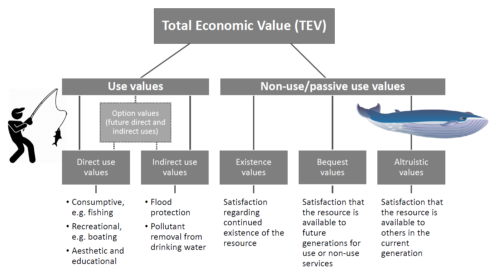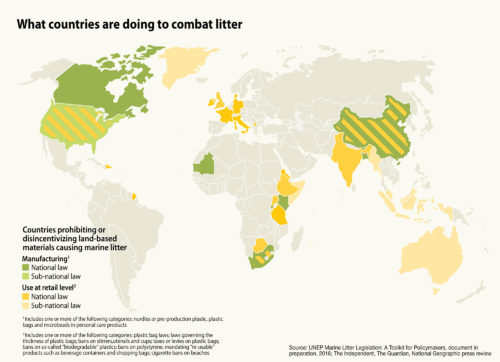Earth’s Value
Alison Thieme ·By: Alison Thieme
If asked, “what is Earth’s value?” how would you respond? Is your response a comment on the importance of Earth, or a number estimate? While most people have a sense of the intrinsic value of our environments, it can be challenging to estimate the monetary value of the natural world. We can use examples like the quantity and price of apples to begin to understand valuation of objects, but with only one Earth, can we afford to consume it like an apple?

CC BY 2.0.
As much of the global economy is tied to the use of natural resources, economics is intertwined with the environment and must be considered when proposing environmental policy changes. This week, Dr. Lisa Wainger led an exploration of environmental economics. We discussed methods of estimating value, some of the ethical considerations of these methods, and how environmental economics can help inform policies.
Economists recognize that market values fail to capture many aspects of how people value their environment. An apple has a market value but can also have value as a model for a still life painting, a tool for discovering gravity, and a food providing fuel. Economists instead expand the definition to include values based on use and non-use of the environment. We can use Total Economic Value (TEV) to estimate the utility, a convenient tool if something has happened to change the utility like an environmental disaster. For example, after the Exxon Valdez oil spill, use and non-use (passive use) values were summed to estimate TEV and calculate damages. Similarly, in the example below we see how TEV can be used in the calculation of reparations for a damaged watershed1.

While being able to calculate TEV is helpful in reparations, conducting a Cost-Benefit Analysis (CBA) is helpful in comparing potential policy changes. The Organisation for Economic Co-operation and Development outlines the steps of a CBA, which essentially assesses potential environmental impacts of a policy, if the policy creates a net benefit and should be undertaken, and the optimal scale of the policy2. A CBA is similar to TEV in that it measures environmental impacts based on an estimated monetary value.
The CBA can also help identify groups who will receive the beneficial impacts of a policy, and who will bear the brunt of the harmful impacts. What happens when the policy with the most social benefit also places added costs on marginalized communities? The uneven distribution of these impacts is at the core of the fight for environmental justice.

CBA is useful to understanding the economic impacts of a policy, and it can be used to make ethical policy decisions, except in cases where a policy contradicts moral imperatives or impinges on the rights of minority groups. In such cases, many environmental economists would apply the Compensation Principle, which dictates that the group that is made better off by a policy should compensate those who are made worse off. The Compensation Principle helps guide economic analysis and policy choice with a moral philosophy. While there are more ethical considerations in using CBA, they can largely be distilled into the rule: "Don’t do anything disgusting"3.
Just as CBA can help us determine the potential monetary effects of a policy, incentives for behavior change can help us enact policy changes that need to be adopted by a society. These fall into three major categories: legal (regulatory driven), economic (market driven), and social (peer driven).
Abbot and Sumaila4 detail policy instruments that incentivize behavior change in regard to plastics. The legal incentives include bans on production, standards for product content, and extended producer responsibility that covers product disposal. Economic incentives for behavior change include things like taxes or fees on producers and disposers, subsidies for recycling, and a combination of taxes and subsidies. Social incentives range from anti-littering campaigns to making recycling bins available in public spaces. These incentives can be combined, such as implementing a small tax for plastic bags while also endorsing the use of reusable bags.

In the DMV we have many examples of environmental policies that address plastic pollution. Which policies (banning plastic straws, plastic bag fees, information campaigns) do you think have been the most effective in changing your individual plastic consumption?
Much of our environmental economics discussion ties back into last week’s conceptualization of sustainability. We try new environmental policies that combine economic theories with behavior change incentives as pieces of the sustainability puzzle. Some businesses, non-profits, and governments have recognized that purely economic valuations (like CBA) fail to capture social and ecological impacts, and have switched to triple bottom line accounting to better evaluate their performance.

This approach is more holistic than CBA, but also struggles to find a common unit of measure since some social and environmental impacts cannot be counted in monetary value5. This issue returns us to the original question: “What is Earth’s value?”
References:
1. Wainger, L. (2019, September). Environmental Economics: Concepts and Application to Public Policy. Presented at the MEES 620, University of Maryland.
2. OECD (2006), Cost-Benefit Analysis and the Environment: Recent Developments, OECD Publishing.
3. Randall, A. (2002). Benefit-cost considerations should be decisive when there is nothing more important at stake. Economics, 53–68.
4. Abbott, J. K., & Sumaila, U. R. (2019). Reducing marine plastic pollution: Policy insights from economics. Review of Environmental Economics and Policy.
5. Slaper, T., & Hall, T. (2011). The Triple Bottom Line: What Is It and How Does It Work? Indiana Business Review, 86(1).
Next Post > Kicking off another semester of Environment and Society
Comments
-
Michael Paolisso 6 years ago
Very interesting and informative blog. I thought the apple/earth image was powerfully symbolic. The inserted links were helpful. They connect to a lot of information; I would have liked to hear what Lisa would say of the information the provide, maybe provide some guidance (I know this is after the fact, her talk). Good links to environmental justice and sustainability. Until a few months ago, I had lived 25 years in DC. I noted and appreciated your use of DMV. Got me thinking. Well done!
-
Faith Taylor 6 years ago
Good idea to mention what has been done locally to reduce plastic waste
-
Taylor Gedeon 6 years ago
I love that how the cartoon "Environmental Justice" depicts multiple issues: the wave (sea level rise), the pollution in the wave, the oil barrels (low-income housing frequently located nearby), etc. Perhaps just my interpretation of the cartoon but I love it.
-
Meg Munkacsy 6 years ago
This was a great synthesis of what we covered in class this week! I also loved all the visuals and including the part of the conversation that revolved around environmental justice.
-
Isabel Sullivan 6 years ago
I enjoyed the graphics that you had! The graphic on "What countries are doing to combat marine litter" was very eye-opening for me. I had no idea that many countries (especially coastal ones) that don't have a plan for negating marine litter. I especially love the "Environmental Justice" cartoon because it is such a strong image!
-
Andrea Miralles-Barboza 6 years ago
If people don't slow down and think about these concepts, there might be no apple left to bite!!
Good job :)
-
Enid Munoz Ruiz 6 years ago
Great post! I really enjoyed the illustrations you depict here. CBAs are very important when it comes to making decisions about the environment.
-
Kayle Krieg 6 years ago
"What happens when the policy with the most social benefit also places added costs on marginalized communities?" EXACTLY! Years ago when CA was dealing with drought issues, some areas moved to a "use more pay more" strategy. This did nothing to deter ultra rich homes, that used the money to fill swimming pools and excessively water non native lawn grasses. Because the added cost of water did not really affect them, many took no steps to lessen water usage. I remember a news segment where a man being interviewed about his luscious green lawn responded by turning on his faucet, and when water came out, he stated that "water comes out, I don't think we have water problem". Some people do not see the real cost of their actions. This is why I agree with Amanda's point that behavior change strategies should be a big part of changing societal norms.
-
Amanda Rockler 6 years ago
Nice post! I am particularly interested in the behavior change pieces and I think the most successful campaigns are the ones that target a specific audience with a very specific behavior. Those that use social diffusion and social norming strategies such as using your blue bins to recycle or using reusable bags seem to get fairly widespread adoption and their impact can be qualitatively and quantitatively measured which is beneficial for long term sustainability measurements. But behavior change is hard so it also might take a long time to get it right!
-
Hamani Wilson 6 years ago
Very nicely written. I wonder why reparations for continuous environmental justice instances are not levied very often. I would be interested in the threshold for what is justified in terms of instances that necessitate reparations. I found your use of graphics particularly helpful.

